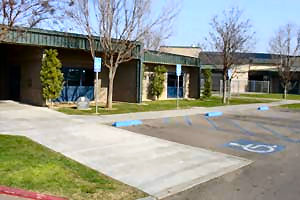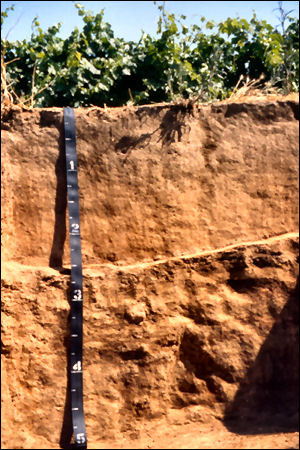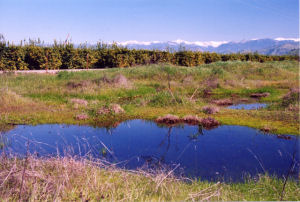California State Soil
| San Joaquin |
|
Adopted:August 20, 1997 |
 |
Martin Luther King, Jr. Middle School
Madera, California |
Adoption of the California State Soil Series
According to the United States Department of Agriculture's National Resources Conservation Service, each state has selected a state soil that has a particular significance for that state. Not all state soils have been established as official by the state legislature however.
Naming, describing, and mapping particular soil types is an ongoing process that began in 1899 when the United States Soil Survey, now known as the National Cooperative Soil Survey, first undertook this monumental effort.
San Joaquin soil was one of the first four soil series recognized in California. Through a series of adjustments and combinations over the years, three of the original four soils were dropped. This means that San Joaquin soil is the oldest, continuously recognized soil within the State of California. 500,000 acres have been identified and mapped in the state.
In 1973, a group of soil scientists in California established an organization, the Professional Soil Scientists Association of California (PSSAC), to promote their profession and to promote knowledge, understanding, and proper management and conservation of soil resources.
 |
San Joaquin Soil Profile
Surface layer: brown Loam
Subsoil-uppper: brown loam
Subsoil-lower: brown clay
Substratum: light brown and brown, indurated duripan with 70 to 90 percent silica-sesquioxide cementation
Courtesy: USDA, Natural Resources Conservation Service |
Members of PSSAC first seriously explored the idea of designating San Joaquin soil as the official state soil. As scientists, the members of PSSAC recognized its interesting soil characteristics, its agricultural significance, its distribution and extent in the state. Its name would also be immediately familiar to state residents as "Californian." Despite careful research and meticulous preparation, their efforts met with little success. Evidently, they were not able to provide the inspiration necessary to move this idea through the California State Legislature.
Perhaps the time was right or perhaps it was the enthusiasm of a group Martin Luther King, Jr. Middle School students, in Madera, that finally got the ball rolling.
As part of an integrated curriculum, science teacher Alex Lehman saw an opportunity to provide students with a meaningful endeavor and a real-world learning experience. In 1996, Mr. Lehman visited Kerry Arroues, Supervisory Soil Scientist, USDA, Natural Resources Conservation Service, in his office in Hanford, California. Mr. Arroues was a member of PSSAC. As Mr. Lehman and Mr. Arroues discussed conservation education for students and for the public, it became obvious that the process of establishing an official state soil would offer a real-world experience that could impact students and the public in meaningful ways.
Mr. Lehman returned to King, Jr. Middle School and kicked off an interdisciplinary project, "Proposing a California State Soil Preserving a Legacy and a Commitment to Future Generations" at a school assembly in January, 1997. Soil awareness through a process of research, study, and legislation were specific goals. Approximately 180 middle school students were involved in some way with the project.
The interdisciplinary approach incorporated conservation education with history, science, math, English, and art studies. An official state soil song was composed in music classes. Science fair displays were created in science and art classes. The legislation process was discussed in social studies and poems and rough-draft legislative proposals were written in English classes.
In addition, the work of PSSAC, completed 20 years earlier, was made available to Mr. Lehman and the middle school students. "History of the San Joaquin Soil," "The Origin and Formation of the San Joaquin Soil," and appropriate maps and soil descriptions offered professional scientific authority to the project.
When Mr. Lehman and his students approached State Senator Dick Monteith with their research and the work of PSSAC, Senator Monteith was impressed and agreed to assist with the project by introducing legislation in the California State Senate that would propose that San Joaquin soil be adopted, by law, as California's official state soil.
On February 14, 1997, Senate Bill No. 389 was introduced by Senator Monteith. [ SB 389 as introduced ]
According to Senate analysis,
Proponents state that soil is California's greatest natural resource. They believe this proposal would recognize the agricultural heritage of the state. And, by declaring a state soil, California will be calling attention to the important role of soil in the economic as well as social life of the state. Also, they contend, that having an official "State Soil" will encourage the study of the soil, and its importance, at all levels in our society--from elementary school on up, and cultivate a desire to promote the good stewardship of our soils.
With no stated opposition and a broad coalition of support from professional scientists, universities, and agricultural interests, SB 389 moved through the process until April 3. On that day, with students looking on, the State Senate erupted in what the April 4 issue of the Fresno Bee referred to as "a tit-for-tat partisan battle." Senate Bill No. 389 was "refused passage."
According to the Fresno Bee, "As the polite, attentive learners looked on Thursday in the Capitol, they watched state senators launch into a tit-for-tat partisan battle--and in the process kill the students' prized, school-project bill to name an official state soil."
Senate President Pro Tem Bill Lockyer, remarked, "I think the Senate ought to be embarrassed today; I am personally."
Senator Monteith kept his wits about him and made a motion to reconsider. It was approved and, two weeks later, the measure was read on the Senate floor again. Senate Bill No. 389 passed through the Senate with 33 yes-votes. Senator Greene voted no and six others did not vote.
 |
| San Joaquin soil landscape from the Hogwallow Preserve in Tulare County, California -- Photo by Edd Russell |
A delegation of 14 students traveled to Sacramento to testify in support of the bill to the Assembly Governmental Organization Committee, but they were told that they would not be able to make their presentations because of a full calendar of scheduled bills. Senator Monteith warned the students that their presentations were likely to go unheard. Perhaps hardened by their experience in the Senate, the students persisted and Senator Monteith agreed to do what he could.
Their persistence paid off and presentations were allowed. Valerie Brown, the Chair of the Assembly Governmental Organization Committee, said: "I'm going to tell you that never in the history of my time here in the legislature, which has been five years, have you ever held members to such attention, and it will truly go down in history as one of the finer moments for this legislature. We actually learned something."
The legislation was approved by the Assembly on June 19, and sent to the Governor Pete Wilson for his signature on June 20, 1997.
It wasn't over yet for SB 389 however. In July, the Governor returned the measure to the legislature for "further action."
In the Assembly, SB 389 was amended on July 21 to eliminate the background information regarding the purposes for declaring San Joaquin soil the official state soil. The amended version of SB 389 was approved by the General Assembly on August 11 and then by the Senate on August 12, 1997.
San Joaquin soil became "the official State Soil" when Senate Bill No. 389 was signed into law by Governor Wilson on August 20, 1997. [ SB 389 as approved ] ]
California Law
The following information was excerpted from the California Government Code, Title 1, Division 2, Chapter 2.
CALIFORNIA GOVERNMENT CODE
TITLE 1. GENERAL
DIVISION 2. STATE SEAL, FLAG, AND EMBLEMS
CHAPTER 2. STATE FLAG AND EMBLEMS
SECTION 420-429.8
425.9. (a) The Legislature finds and declares that San Joaquin Soil is the official soil of California. It is one of four soils to be originally described at the beginning of this century, and the beginning of soil studies in California. San Joaquin Soil is approximately 50,000 to 250,000 years old and was derived from and deposited by the runoff of swollen streams during the glacial period, from mountain glaciers in the Sierra Nevada.
(b) The Legislature hereby designates San Joaquin Soil as the official State Soil.
Source: California State Legislature, California Law, February 19, 2008.
Source: National Cooperative Soil Survey Centennial Highlights:Papers for the 1998 Annual Conference of the Soil and Water Conservation Society, Students and Education Commitment in Making the San Joaquin Soil “The Official State Soil of California”, by Kerry Arroues, Supervisory Soil Scientist, NRCS, Hanford, Calif., July 1998.
Source: The Professional Soil Scientists Association of California, The California State Soil, February 19, 2008.
Source: USDA:NRCS, State Soils, February 19, 2008.
Source: State Names, Seals, Flags and Symbols: A Historical Guide Third Edition, Revised and Expanded by Benjamin F. Shearer and Barbara S. Shearer. Greenwood Press; 3 Sub edition (October 30, 2001).
Additional Information
What is Soil?:
From the United States Department of Agriculture, National Resources Conservation Services.
California State Soil:
Soil health from the National Resources Conservation Services.
California State soil:
"How the San Joaquin Soil Became the California State Soil" and "History of Recognition and Development of the San Joaquin Soil" from the Professional Soil Scientists Association of California website.
Published Soil Surveys for California:
United States Department of Agriculture, National Resources Conservation Services.
State Soils:
From the United States Department of Agriculture, National Resources Conservation Services.
State Soils:
Complete list of official state soils from NETSTATE.COM.
|





